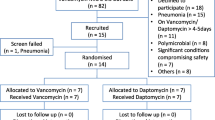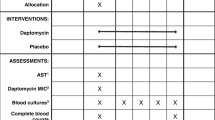Abstract
Daptomycin is bactericidal against Staphylococcus aureus, with susceptibility defined as a minimal inhibitory concentration (MIC) ≤1 μg/ml. Higher MIC developed in a few cases during therapy. The frequency of MIC rise in persistent bacteremia is unknown. We evaluated all patients with S. aureus bacteremia (SAB) treated with daptomycin (≥2 days) from 1 April 2004 to 30 October 2006. All patients with post-daptomycin-exposure saved isolates were studied. Daptomycin susceptibility was determined (in duplicate) on all pre- and post-daptomycin-exposure isolates by the broth (Mueller-Hinton) microdilution method. Among 74 treatment courses in 67 patients, 18 were for SAB. Ten had persistent bacteremia (median = 11 days; range = 1–21) and post-daptomycin-exposure saved isolates. The patient age was 29–84 years (median = 57.5 years). Intravascular catheter was the most common source (50%). Most patients (90%) failed therapy prior to starting daptomycin. The initial daptomycin dose was 4 mg/kg in four (40%) cases. The pre-exposure MIC was 0.125–0.5 μg/ml. The post-exposure MIC increased in four cases and was elevated in two cases (60%), to 2 μg/ml in five and 4 μg/ml in one. MIC rise was noted within 5–15 days of exposure and persisted up to 247 days after stopping daptomycin. Pulse-field gel electrophoresis (PFGE) band pattern of isolates with increased MIC revealed 1–3-band differences, implying genetic relatedness. All patients with non-susceptible isolates relapsed or failed therapy. These findings illustrate that daptomycin susceptibility often decreases during the treatment of persistent SAB. Therefore, susceptibility should be closely monitored during therapy.

Similar content being viewed by others
References
Carpenter CF, Chambers HF (2004) Daptomycin: another novel agent for treating infections due to drug-resistant gram-positive pathogens. Clin Infect Dis 38:994–1000
Clinical and Laboratory Standards Institute (CLSI) (2006) Performance standards for antimicrobial susceptibility testing: 16th information supplement. CLSI document M100–S16, National Committee for Clinical Laboratory Standards (NCCLS), Wayne, PA
Fowler VG Jr, Boucher HW, Corey GR, Abrutyn E, Karchmer AW, Rupp ME, Levine DP, Chambers HF, Tally FP, Vigliani GA, Cabell CH, Link AS, DeMeyer I, Filler SG, Zervos M, Cook P, Parsonnet J, Bernstein JM, Price CS, Forrest GN, Fätkenheuer G, Gareca M, Rehm SJ, Brodt HR, Tice A, Cosgrove SE; S. aureus Endocarditis and Bacteremia Study Group (2006) Daptomycin versus standard therapy for bacteremia and endocarditis caused by Staphylococcus aureus. N Engl J Med 355:653–665
Hayden MK, Rezai K, Hayes RA, Lolans K, Quinn JP, Weinstein RA (2005) Development of daptomycin resistance in vivo in methicillin-resistant Staphylococcus aureus. J Clin Microbiol 43:5285–5287
Hirschwerk D, Ginocchio GC, Bythrow M, Condon S (2006) Diminished susceptibility to daptomycin accompanied by clinical failure in a patient with methicillin-resistant Staphylococcus aureus bacteremia. Infect Control Hosp Epidemiol 27:315–317
Mangili A, Bica I, Snydman DR, Hamer DH (2005) Daptomycin-resistant, methicillin-resistant Staphylococcus aureus bacteremia. Clin Infect Dis 40:1058–1060
Marty FM, Yeh WW, Wennersten CB, Venkataraman L, Albano E, Alyea EP, Gold HS, Baden LR, Pillai SK (2006) Emergence of a clinical daptomycin-resistant Staphylococcus aureus isolate during treatment of methicillin-resistant Staphylococcus aureus bacteremia and osteomyelitis. J Clin Microbiol 44:595–597
Skiest DJ (2006) Treatment failure resulting from resistance of Staphylococcus aureus to daptomycin. J Clin Microbiol 44:655–656
Li JS, Sexton DJ, Mick N, Nettles R, Fowler VG Jr, Ryan T, Bashore T, Corey GR (2000) Proposed modifications to the Duke criteria for the diagnosis of infective endocarditis. Clin Infect Dis 30:633–638
Tenover FC, Arbeit RD, Goering RV, Mickelsen PA, Murray BE, Persing DH, Swaminathan B (1995) Interpreting chromosomal DNA restriction patterns produced by pulsed-field gel electrophoresis: criteria for bacterial strain typing. J Clin Microbiol 33:2233–2239
Zhang K, McClure J, Elsayed S, Louie T, Conly JM (2005) Novel multiplex PCR assay for characterization and concomitant subtyping of staphylococcal cassette chromosome mec types I to V in methicillin-resistant Staphylococcus aureus. J Clin Microbiol 43:5026–5033
Sakoulas G, Mollering RC Jr, Eliopoulos GM (2006) Adaptation of methicillin-resistant Staphylococcus aureus in the face of vancomycin therapy. Clin Infect Dis 42:S40–S50
Friedman L, Alder JD, Silverman JA (2006) Genetic changes that correlate with reduced susceptibility to daptomycin in Staphylococcus aureus. Antimicrob Agents Chemother 50:2137–2145
Patel JB, Jevitt LA, Hageman J, McDonald LC, Tenover FC (2006) An association between reduced susceptibility to daptomycin and reduced susceptibility to vancomycin in Staphylococcus aureus. Clin Infect Dis 42:1652–1653
Cui L, Ma X, Sato K, Okuma K, Tenover FC, Mamizuka EM, Gemmell CG, Kim MN, Ploy MC, El-Solh N, Ferraz V, Hiramatsu K (2003) Cell wall thickening is a common feature of vancomycin resistance in Staphylococcus aureus. J Clin Microbiol 41:5–14
Kaatz GW, Lundstrom TS, Seo SM (2006) Mechanisms of daptomycin resistance in Staphylococcus aureus. Int J Antimicrob Agents 28:280–287
Acknowledgments
This study was supported by medical education funds from the St. John Hospital & Medical Center. The daptomycin powder for in vitro testing was kindly provided by Cubist Pharmaceuticals. We wish to thank Joseph R. Kipisz RPh and Michael Lucey from the pharmacy department for their assistance.
Author information
Authors and Affiliations
Corresponding author
Rights and permissions
About this article
Cite this article
Sharma, M., Riederer, K., Chase, P. et al. High rate of decreasing daptomycin susceptibility during the treatment of persistent Staphylococcus aureus bacteremia. Eur J Clin Microbiol Infect Dis 27, 433–437 (2008). https://doi.org/10.1007/s10096-007-0455-5
Received:
Accepted:
Published:
Issue Date:
DOI: https://doi.org/10.1007/s10096-007-0455-5




